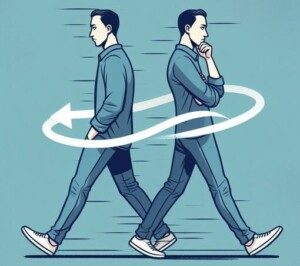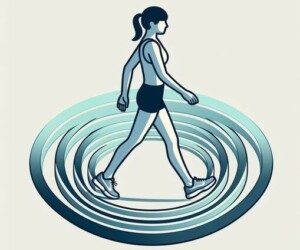
If you pace a lot as a stimming behavior, you should keep on doing this; it can help offset “the sitting disease.” Pacing is a common stim among autistic people.
Threads about stimming on autismforums.com and wrongplanet.net verify this. Some autistic people pace because it’s self-regulating, equivalent to gentle rocking or foot flapping while seated.
Pacing can help autistic people process information and enhance their focus on a topic.
But often, when autistic people pace, it’s because they’re anxious or feeling stressed.
In fact, neurotypical people pace too. Just visit any hospital waiting room full of men whose wives are in labor. NTs may also pace about while talking on the phone.
With that all said, pacing is done much more often among the autistic population.
Why is pacing as an autistic stim good for the body?

It contributes to one’s daily step quota, or, to put another way, reduces time spent in a chair.
One study after another shows a strong association between excess sitting to a host of ailments.
Obviously, the less you sit, the more steps you get in each day. And the more steps, the better for your health – up to a point, according to one large study.
What this means is that 7,000 to 10,000 steps per day are associated with increased lifespan and other health benefits, but the benefits don’t further increase with more than 10,000.
However, if you’re getting in only 4,000 steps a day, an increase to 5,000 is meaningful. If you’re getting 5,000, an increase to 6,000 is beneficial.
There’s a definite correlation between a low daily step count and premature death from any medical cause.
If you spend large chunks of the day pacing, this may give you health benefits and/or contribute to a longer life.
Pacing is one stimming behavior you won’t want to cut back on, even if other people point out that you do it excessively.
The irony is that, if anyone’s been calling you out for pacing too much, there’s a good chance that they spend way too much time sitting.
How to Increase Your Daily Step Total
• Pace or walk around while you’re on hold over the phone, as well as when you’re in conversation.
• Walk about while watching TV or during commercial breaks.
• When it’s time to lean back in your chair to collect your thoughts or think about something, get up and walk about and see if you can generate the same degree of concentration on your thoughts.
• If you’ve reached a point where you’re stressed out and feel compelled to stay put in a chair, get up and walk about.
• Buy a treadmill desk so you can do some of your computer work on it. I’ve had one for many years. The speed can be as slow as one-half mph.
• Buy a regular treadmill and every so often, walk on it for five to 10 minutes. Don’t hold on, as this can disrupt normal gait.
 Lorra Garrick has been covering medical and fitness topics for many years, having written thousands of articles for print magazines and websites, including as a ghostwriter. She’s also a former ACE-certified personal trainer. In 2022 she received a diagnosis of Level 1 Autism Spectrum Disorder.
Lorra Garrick has been covering medical and fitness topics for many years, having written thousands of articles for print magazines and websites, including as a ghostwriter. She’s also a former ACE-certified personal trainer. In 2022 she received a diagnosis of Level 1 Autism Spectrum Disorder.
Do ALL Autistic People Have Impairment with Executive Function?
Free Service Helps Autistic People Find Inclusive Employment
Autistic Man Builds Muscle Lifting Weights; has Fitness Site
Can Autism Be Ruled Out if the Patient Has Good Eye Contact?
Autistic Special Interest vs. Neurotypical Hobby: the Difference?


























